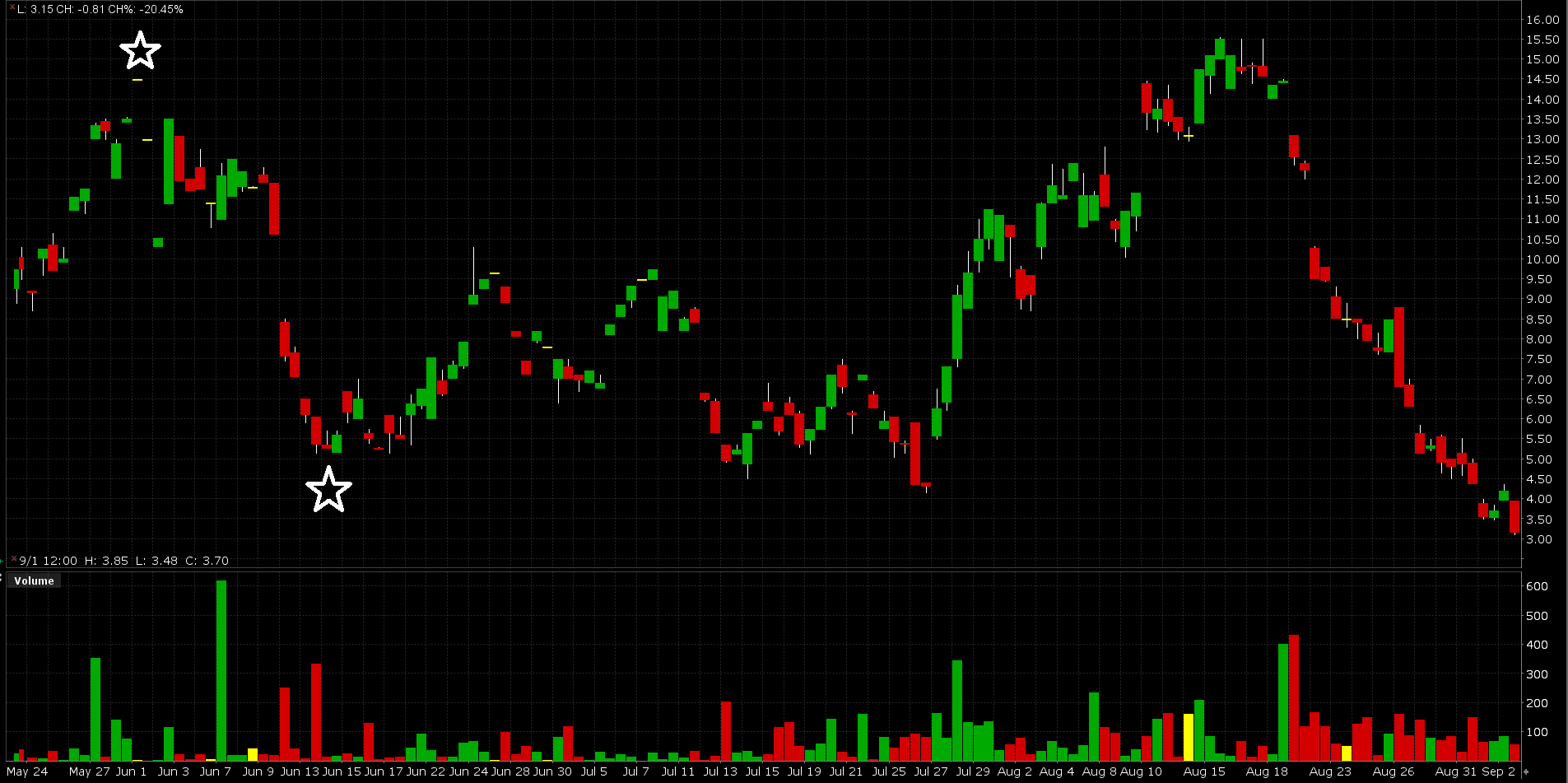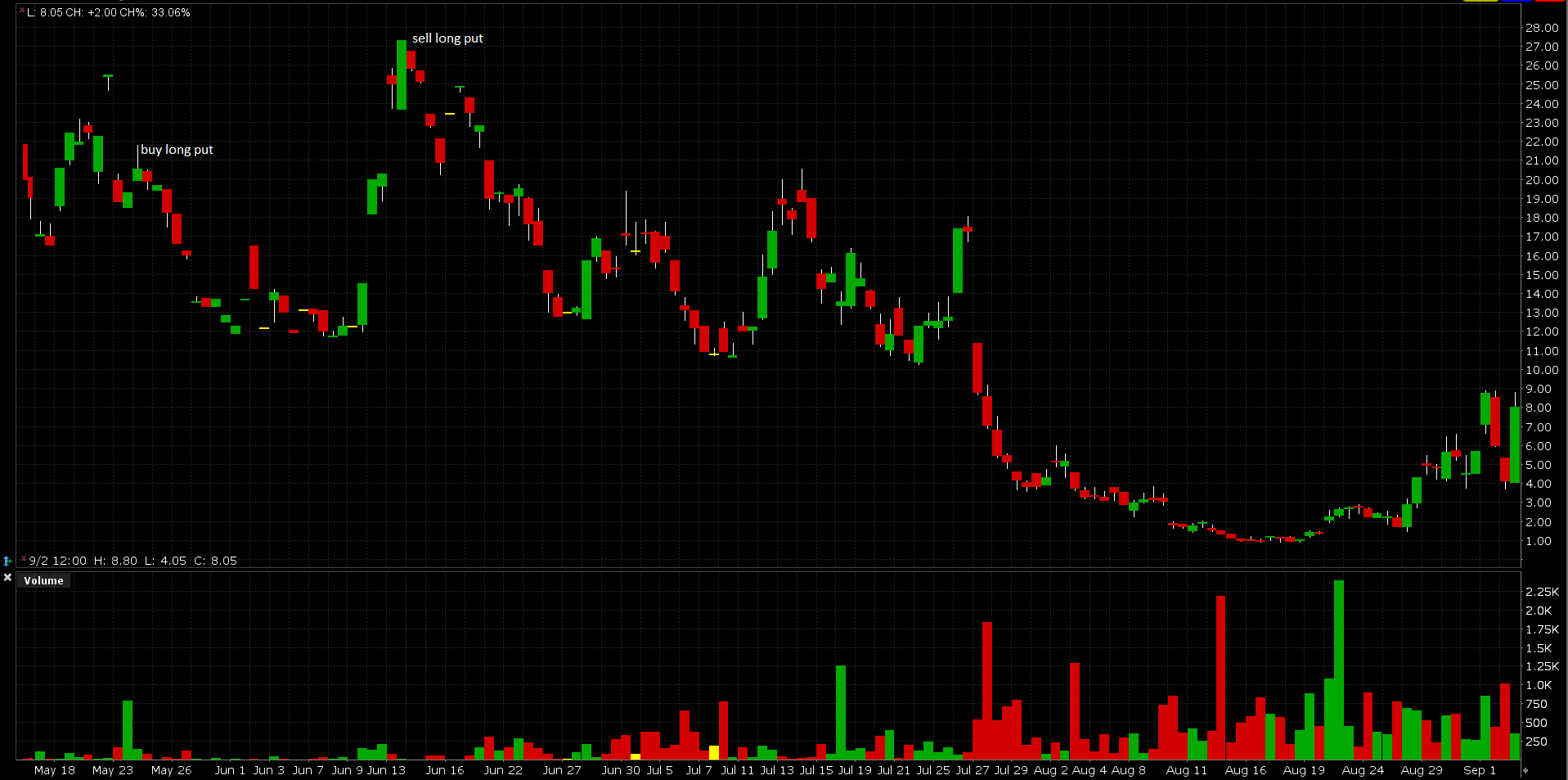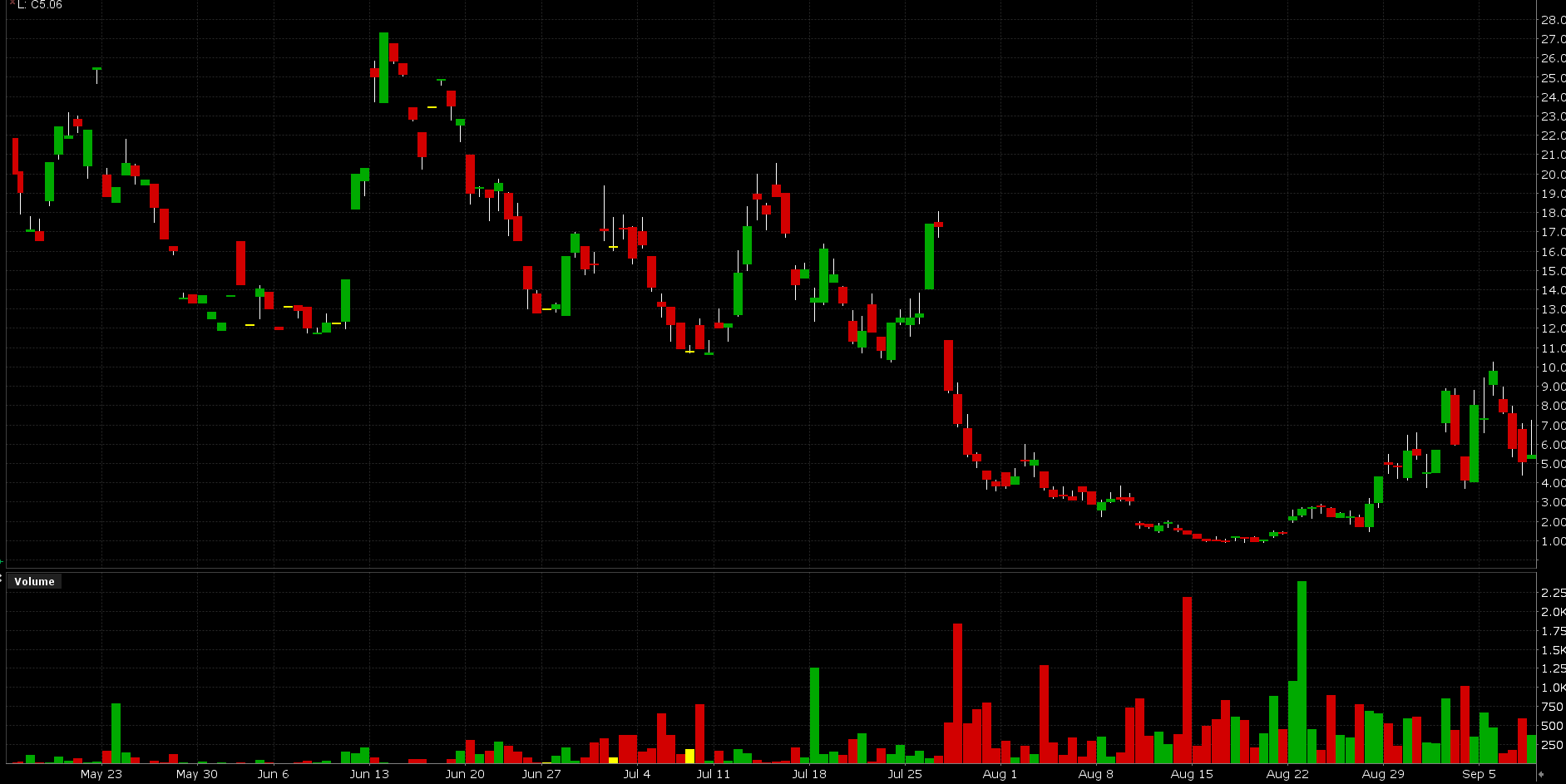How to manage a losing position in the options market
Investing in options to many it seems very simple. After all, it is enough to buy an option, correctly select the direction of the price change and hundreds of percent of profit are at your fingertips. For this reason, many beginner traders focus on buying "cheap" Deep Out of The Money (DOTM) options in hopes of achieving a three-digit rate of return very quickly. However, managing an option position is not as easy as it initially seems. The price of an option is highly influenced by Greek factors, which may cause an increase or decrease in the value of a given option. For this reason, you should carefully consider how to manage your position. In today's article, we will present the basic issues related to managing a losing position on the options market. We invite you to read!
READ: Investing in options and managing a profitable position
Basic issues
As always "Backward analysis is always effective". For this reason, many options market beginners look at historical charts and “analyze” the position in terms of historical performance. Then the investor always "knows" how to behave, that is "Cut losses and let profits grow". However, it is very difficult, and applying this golden sentence in the options market seems even more difficult. This especially applies to losses on short positions on the options market, where the potential loss may be even several times the potential profit.. By analyzing the chart from the perspective of the past, it would be possible to mark the "ideal" place to take and close a position. However, real-time position management and the use of "back analysis" are two different disciplines. Later in this article we will discuss the most popular strategies for managing a losing position.
Managing a losing position is neglected by many. After all, you have to "cut losses". However, nothing is black and white. For this reason, along with your entry strategy, you need to develop an exit or hedge strategy for a losing position in the options market. In today's article, we will present how to manage a losing position when you have:
- long position in the call option,
- short position in the call option,
- a long position in the put option,
- a short position in a put option.
Managing a long position in a call option
By taking a long position in a call option, the investor gets the right to buy the underlying asset at a certain price within a certain period of time. In return for acquiring this right, the investor must pay an "option premium" which is the maximum loss the investor may incur. For example, if an investor purchased a call option on June 1, 2022 Microsoft shares (MSFT) with an exercise price of $ 300 and an expiration date of December 16, 2022. He paid $ 14,5 per share for it, considering that 1 option is on 100 Microsoft shares, the transaction value was $ 1450. At the time of the purchase of the option, Microsoft's stock was trading at $ 277. This gave the investor hope that the MSFT rate will increase soon and will generate a very good rate of return. However, the market had other plans. By June 13, Microsoft stock had dropped just below $ 242. This meant that over 8 sessions (and 12 days) MSFT stock declined by 12,6%. This caused the December option price (with an exercise price of $ 300) to drop by over 64%. On June 13, 2022, the option was traded for as high as $ 5,15.
In the current situation, the investor can:
- to keep possiton,
- close the position,
- buy a put option,
- issue a call option,
- roll up the item.
Holding a position is sometimes a good idea if you are going long on a call option. This is because the maximum loss an investor may incur is the premium paid. However, you should realize that sometimes it is better to quickly lose 40% of the invested capital and allocate it to a more promising position than to force "freeze" capital on a poorly promising transaction just to protect your ego. It's worth having a mental one stop losses (valuable or time-based) to allocate your own capital efficiently. Of course, using this strategy only makes sense when:
- the trend is still upward (there is therefore a good chance for a "rebound"),
- the option has a long enough life to make it worth the "give a chance" position .
Closing a position is the second way to deal with a losing trade. It is simply accepting your loss. Obviously, in such a situation there is no risk of further losses on the position (apart from the commission paid). However, the disadvantage of such a solution is the possibility of missing the chance to "bounce". If the investor closed the position on June 13, 2022, he would regret that if he held the position until August 15, he would have generated a profit on the transaction of 7,2% (excluding the commission).
Buying a put option is a solution that allows you to protect yourself against the risk of a deeper correction or a downward trend change. This has its advantages when purchasing long-term call options (LEAPS). Then, the use of short or medium-term put options will allow you to earn during the market correction. To better illustrate such a strategy, we will use an example. On May 17, 2022, 1 Microsoft share was valued at $ 267. The investor decided to purchase 1 call option with an exercise price of $ 300, which will expire in January 2024. The premium paid by the investor was $ 31,6 per share, i.e. the value of the premium paid was $ 3160.
On May 24, Microsoft's stock price fell to $ 259. As a result, the value of the purchased call option dropped to $ 25. The investor began to fear that in the next three months there will be a correction in Microsoft shares. For this reason, he bought a put option with an exercise price of $ 3 expiring in September 260. The value of the bonus was $ 2022 per share, or $ 19,5. By June 1950, 13, Microsoft's share price had dropped to $ 2022. As a result, the put option price increased to $ 241,7, while the call option price dropped to $ 27,3. This meant that after less than a month, the transaction on the long-term call option recorded a loss of $ 21,2 per share, while the profit on the acquired put option was $ 10,4. After closing a position in a put option, the investor will cover a significant part of the loss generated by a long position on LEAPS options on Microsoft stocks.
| purchase price | Price as of June 13, 2022 | % change | |
| Call option | 31,6$ | 21,2$ | -32,9% |
| Put option | 19,5$ | 27,3$ | + 40 % |
| Together | 51,1$ | 48,5$ | -5,1% |
Source: own study
Writing a call option in the event of a loss on call options allows you to reduce the potential loss in the event of a scenario assuming a further moderate decline or consolidation of the price after a decline. Of course, this only makes sense when the investor has a long position in a long-term call option and issues a call option with a much shorter exercise period. This allows for a potential loss reduction in the event of a positive scenario. The risk is a situation in which there will be a return to the upward trend. In such a situation, an option with a shorter period to expiry may increase much more than a long-term call option (here a lot depends on option deltas). Let us use an example to illustrate the strategy. As before, on May 17, the investor purchased 1 call option with a strike price of $ 300, which will expire in January 2024. He paid $ 31,6 per share for it.
On May 24, Microsoft's stock price fell to $ 259. As a result, the value of the purchased call option dropped to $ 25. The investor began to fear that in the next three months there will be a correction in Microsoft shares. For this reason, he issued a call option with an exercise price of $ 3 expiring in September 260. The premium was $ 2022 per share ($ 19,5). By June 1950, Microsoft's rate had dropped to $ 13. As a result, the price of the issued call option dropped to $ 241,7, while the price of the call option dropped to $ 10,5. This meant that after less than a month, the transaction on the long-term call option recorded a loss of $ 21,2 per share, while the profit on the acquired put option was $ 10,4. After closing a position in a put option, the investor will cover a significant part of the loss generated by a long position on LEAPS options on Microsoft stocks.
| Transaction price | Price as of June 13, 2022 | Profit / loss on the transaction | |
| long call | 31,6$ | 21,2$ | -10,4 $ |
| short call | 19,5$ | 10,5$ | + 9,0 $ |
Source: own study
Rollover involves closing your current losing position and opening a new one with a longer expiry date or a lower strike price.. Occasionally, the position can be rolled "to the spread" when a spread is established to save a losing position. Another solution is to simply roll down. Closing a lossy option and opening a new one with a higher delta. Use an example to understand your strategy. On June 8, an investor purchased a call option for Microsoft shares with an exercise price of $ 260 and expiring on September 16, 2022. For this option, the investor paid $ 25 per share (ie $ 2500). This resulted in a transaction profitability (BEP) level of $ 285 per share ($ 260 + premium paid). After 5 days, the Microsoft share price started a downward impulse which led to a drop in the option price to around $ 10,5. The investor decided to save the position by selling a call option with the same parameters as the previously purchased option. The sale of options resulted in the close at a loss of the old position. Due to the fact that the investor still believes in the increase in Microsoft's price, he believes that he should have some call option with a sufficiently high delta. For this reason, he buys call options with an exercise price of $ 250 expiring on September 16, 2022. The investor has to pay $ 15 for this option. After the transaction, there was an upward correction that lasted until mid-August. In effect:
- the $ 250 strike call option increased from $ 15 to $ 43;
- The strike option at $ 260 went up from $ 10,5 to $ 33.
If the trader had not closed the position, he would have made a profit of $ 8 per share ($ 800). However, he realized a loss of $ 14,5 ($ 1450) on the trade. At the same time, the purchased call option with the strike price of $ 250 generated a profit of $ 28. As a result, the net profit on the two trades was $ 13,5, more than the call option itself. The disadvantage of such a strategy is the need to find funds to open a new position because closing a call option with an exercise price of $ 260 generated an inflow of funds of $ 10,5, and the purchase of a new option required an investment of $ 15. This can be solved by using a call option deep beyond the money or using a brokerage loan.
Managing a short position in a call option
By opening a short position in a call option, the investor undertakes to sell the underlying instrument at a specified price within a specified period of time. In return for accepting this commitment, the investor receives an "option premium" which is the maximum profit the investor can make.
For example, if an investor issued a call option for Microsoft shares on June 13, 2022 with an exercise price of $ 260 and an expiry date of September 16, 2022. He received $ 10,5 per share for it (the value of the transaction was $ 1050). After fourteen days, the option rate increased to $ 21. This means that the transaction loss (after excluding transaction costs) was $ 10,5 per share. This means that the loss is already equal to the maximum profit on the transaction.
In the current situation, the investor can:
- let the loss grow
- close the position
- buy a call option
- rolling the position
Allowing to lose to grow is not the right strategy for a written call option. The reason is that the maximum profit is predetermined, while the potential loss can greatly exceed the potential profit. Therefore, in order to properly manage the risk, the investor should decide to set mental stop losses (price and time) to prevent a single transaction from leading to significant losses of the entire investment portfolio.
Closing a position is a reasonable choice as it allows you to limit the risk of multiplication of your loss. This is especially true of stories where a significant one has appeared short squeeze (ie making holders of short positions to panic close out). History knows the case of many companies that were able to grow by several hundred percent in a very short time (e.g. GameStop, Volkswagen).
Buying a call option allows you to protect yourself against the situation when the investor is afraid that a short, upward correction on the underlying instrument is possible. However, such a solution is puzzling from the point of view of portfolio risk management. If writing a call option carries the risk of generating a huge loss in the event of an upward correction, maybe a better solution is to close a short position with a loss and buy a call option?
Rolling over a position involves closing the current position and opening a second position with a different strike price or a different expiry period. An example is transactions in Microsoft stock options. On July 26, 2022, the investor put a call option on Microsoft shares with an exercise price of $ 260. The options expired in September 2022 and he was paid $ 7,5 per share. By August 15, the option rate had risen to $ 34,50. This meant a trade loss of $ 27. However, the investor decided that there was a chance for a significant, downward correction. For this reason, he decided to close a short position on a call option and open a new short position with a higher intrinsic value (strike price of $ 250, also maturing in September). The investor received a bonus of $ 44 per share. Until September 2, there was a downward wave in Microsoft stocks, which led to a drop in the price of call options to around $ 10 per share. As a result, the profit on the transaction was $ 34. This meant that the profit on the new position more than covered the loss on the previous trade. If the trader had survived the loss on the first trade, his profit would have been around $ 3,5 instead of the $ 7 profit from a successful rollover.
Managing a short position in the put option
By opening a short position in a put option, the trader undertakes to buy the underlying at a certain price within a certain period of time. In return for accepting this commitment, the investor receives an "option premium" which is the maximum profit the investor can make. At the same time, the investor is exposed to the risk of a sharp drop in the price of the underlying instrument, which will cause the loss to significantly exceed the maximum profit. Sometimes investors put up a put option to buy a stock at a lower price than the current price ("making money" on a time premium).
For example, on June 8, 2022, an investor issued a put option on Microsoft shares with an exercise price of $ 260 and an expiry date in September 2022. He received $ 12 per share for it, considering that 1 option is issued for 100 Microsoft shares, the transaction value was $ 1200. By June 13, 2022, the option price had increased to $ 27,3. This means that the investor has generated a loss of $ 1530.
In the current situation, the investor can:
- let the loss grow
- close the position,
- buy a put option,
- rolling the position.
Allowing the loss to grow is not the right strategy for a written put option. The reason is that the maximum profit is predetermined, while the potential loss may well exceed the potential profit (stocks or indexes may drop to 0). Therefore, in order to properly manage the risk, the investor should decide to set mental stop losses (price and time) to prevent a single transaction from leading to significant losses of the entire investment portfolio.
Closing a position is a sensible choice as it allows you to limit the risk of multiplying your loss. This is especially true in stories where there has been a significant drop in the share price triggered by market panic or a fundamental factor. It is enough to mention how the scandal with diesel engines negatively affected the share price of the Volkswagen automotive concern.
Buying a put option allows you to protect yourself against a situation when the investor is afraid that a short, downward correction on the underlying instrument is possible. However, such a solution is puzzling from the point of view of portfolio risk management. If issuing a put option involves the risk of generating a huge loss in the event of a downward correction, maybe a better solution is to close a short position with a loss and buy a put option?
As mentioned before, rolling a position involves closing the current position and opening a second position with a different strike price or a different expiry period. An example is transactions in Microsoft stock options.
On June 8, 2022, the investor issued a put option on a Microsoft share with an exercise price of $ 260. The options expired in September 2022 and he was paid $ 12,3 per share. By June 13, the option price had risen to $ 27,3. This meant a trade loss of $ 15. However, the investor decided that there was a chance for a significant, downward correction. For this reason, he decided to close a short put position and to open a new short position with a higher intrinsic value (strike price of $ 270, also maturing in September). The investor received a bonus of $ 34,5 per share. Until August 15, there was an increase in Microsoft's rate. This led to a drop in the put option price to $ 2 per share. The profit on the transaction was $ 32,5, which more than covered the loss on the previous option. If the trader had survived the loss on the first trade, his profit would have been around $ 11 instead of the $ 17,5 profit from a successful rollover.
Managing a long position in the put option
By taking a long position in a put option, the trader gets the right to sell the underlying at a certain price within a certain period of time. In return for acquiring this right, the investor must pay an "option premium" which is the maximum loss the investor may incur.
For example, if an investor purchased a put option on Microsoft shares on June 13, 2022 with an exercise price of $ 260 and an expiry date in September 2022. He paid $ 27,3 per share for it. On June 24, 2022, the option price fell to $ 12,75. This means the transaction loss (after excluding transaction costs) was $ 14,55 per share ($ 1455).
In the current situation, the investor can:
- to keep possiton,
- close the position,
- buy a call option,
- issue a put option,
- roll up the item.
Allowing losses to rise on the one hand still gives you the chance to close the trade at a profit (if there is plenty of time to expire). Obviously, this is a strategy to hold the loss in the hope of reversing the trend of the underlying asset.
Closing a loss-making position means that the investor agrees that not all positions need to generate profit. Sometimes this is the optimal strategy because it allows you to save at least a part of the premium paid. Of course, it is worth considering whether temporary increases in the underlying instrument are not a good opportunity to increase the position if the probability of decreases is greater than the probability of increases.
Buying a call option is a solution that allows you to protect yourself against the risk of a deeper correction or a change in the upward trend. This has its advantages when purchasing long-term put options (LEAPS). Then, the use of short- or medium-term call options will allow you to profit during the market correction. To better illustrate such a strategy, we will use an example.
On May 20, 2022, 1 Microsoft share was valued at $ 252. The investor has decided to buy 1 put option with an exercise price of $ 300, which will expire in January 2024. The premium paid by the investor was $ 68 per share, i.e. the value of the premium paid was $ 6800. On July 7, Microsoft's stock price rose to $ 267,8. As a result, the value of the purchased put option fell to $ 52,5. The investor began to fear that in the perspective of the next three months there will be an upward correction in Microsoft shares. For this reason, he purchased a call option with an strike price of $ 3 expiring in September 270. The value of the bonus was $ 2022 per share, or $ 9,25. By August 925, 15, Microsoft's share price had risen to $ 2022. As a result, the price of the call option increased to $ 292,8, while the price of the put option dropped to $ 17,5.
This meant that after less than a month, a transaction on a long-term put option recorded a loss of $ 31 per share, while the profit on the acquired call option amounted to $ 8,25. After closing a position in a call option, the investor will cover some of the loss generated by a long position on LEAPS options on Microsoft stocks.
Issuing a put option in the event of a loss on put options allows you to reduce the potential loss in the event of a scenario assuming a further moderate increase or consolidation of the rate after a decline. Of course, this only makes sense if the investor has a long position in a long-term put option and issues a put option with a much shorter exercise period. This allows for a potential loss reduction in the event of a positive scenario. The risk is a situation in which there will be a return to the downward trend. In such a situation, an option with a shorter period of time to expiry may increase much more than a long-term call option (here a lot depends on the option delta).
Rollover involves closing your current losing position and opening a new one with a longer option expiry date or a lower strike price. Occasionally a position can be rolled over to the spread, when a spread is created to save a losing position. Another solution is to simply roll up. Closing a lossy option and opening a new one with a higher delta. Use an example to understand your strategy.
On May 20, the investor purchased a put option on Microsoft shares with an exercise price of $ 260 and expiring on September 16, 2022. For this option, the investor paid $ 25,5 per share (i.e. $ 2550). This resulted in a transaction profitability (BEP) level of $ 285,5 per share ($ 260 + premium paid). Until June 1, 2022, the Microsoft share price was moving in an upward impulse. As a result, the put option price fell to $ 11,8. The investor decided to save the position by selling a put option with the same parameters as the previously purchased option. The sale of options resulted in the close at a loss of the old position. Due to the fact that the investor still believes in the decline in Microsoft's exchange rate, he believes that he should have some put option with a sufficiently high delta. For this reason, he buys call options with an exercise price of $ 270 expiring on September 16, 2022. For the mentioned option, the investor has to pay $ 15,5. After the transaction, there was a downward correction that lasted until mid-June. In effect:
- a put option with an exercise price of $ 260 rose from $ 11,8 to $ 27,3;
- a put option with a strike of $ 270 rose from $ 15,5 to $ 34.
If the trader had not closed the position, he would have made a profit of $ 1,8 per share ($ 180). However, it realized a loss of $ 13,7 ($ 1370) on the trade. At the same time, the purchased put option with an exercise price of $ 270 generated a profit of $ 18,5. As a result, the net profit from the two trades was $ 4,8, which is more than in the case of the put option itself. The downside of this strategy is the need to find funds to open a new position because closing a put option with an exercise price of $ 260 generated an inflow of funds of $ 11,5, and the purchase of a new option required an investment of $ 15,5. This can be solved by using a call option deep beyond the money or using a brokerage loan.
Do you know that…?
Saxo Bank is one of the few Forex brokers that offers vanilla options. The investor has a total of over 1200 options at his disposal (currencies, stocks, indices, interest rates, raw materials). CHECK






















![Forex Club – Tax 9 – Settle tax on a foreign broker [Download the Application] Forex Club - Tax 9](https://forexclub.pl/wp-content/uploads/2024/02/Forex-Club-Podatek-9-184x120.jpg?v=1709046278)
![Trading View platform – solutions tailored to the needs of traders [Review] trading view review](https://forexclub.pl/wp-content/uploads/2024/03/trading-view-recenzja-184x120.jpg?v=1709558918)
![How to connect your FP Markets account to the Trading View platform [Guide] fp markets trading view](https://forexclub.pl/wp-content/uploads/2024/02/fp-markets-trading-view-184x120.jpg?v=1708677291)
![How to invest in ChatGPT and AI? Stocks and ETFs [Guide] how to invest in chatgpt and artificial intelligence](https://forexclub.pl/wp-content/uploads/2023/02/jak-inwestowac-w-chatgpt-i-sztuczna-inteligencje-184x120.jpg?v=1676364263)


![WeWork – the anatomy of the collapse of a company valued at $47 billion [WeWork, part II] wework bankruptcy story](https://forexclub.pl/wp-content/uploads/2024/04/wework-bankructwo-historia-184x120.jpg?v=1711729561)
![Adam Neumann – the man who screwed up Softbank [WeWork, part AND] adam neumann wework](https://forexclub.pl/wp-content/uploads/2024/04/adam-neumann-wework-184x120.jpg?v=1711728724)





![How to transfer shares to another brokerage office [Procedure description] how to transfer shares to another brokerage house](https://forexclub.pl/wp-content/uploads/2024/03/jak-przeniesc-akcje-do-innego-biura-maklerskiego-184x120.jpg?v=1709556924)

![The most common mistakes of a beginner trader - Mr Yogi [VIDEO] Scalping - The most common mistakes of a beginner trader - VIDEO](https://forexclub.pl/wp-content/uploads/2024/03/Scalping-Najczestsze-bledy-poczatkujacego-tradera-VIDEO-184x120.jpg?v=1711601376)
![Learning patience: No position is also a position - Mr Yogi [VIDEO] Scalping - Learning patience - No position is also a position - VIDEO](https://forexclub.pl/wp-content/uploads/2024/03/Scalping-Nauka-cierpliwosci-Brak-pozycji-to-tez-pozycja-VIDEO-184x120.jpg?v=1710999249)
![When to exit a position and how to minimize losses - Mr Yogi [VIDEO] Scalping - When to exit a position and how to minimize losses - VIDEO](https://forexclub.pl/wp-content/uploads/2024/03/Scalping-Kiedy-wyjsc-z-pozycji-i-jak-minimalizowac-straty-VIDEO-184x120.jpg?v=1710336731)













